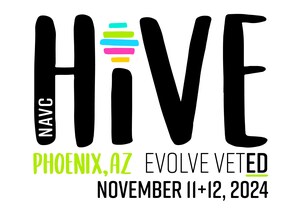ORLANDO, Fla., Sept. 1, 2020 /PRNewswire/ -- More than 45 million household pets suffer from chronic or acute pain. With Americans spending more time at home with their pets than ever before, Dr. Dana Varble, Chief Veterinary Officer of the North American Veterinary Community (NAVC) offers tips and advice for pet owners and veterinarians to recognize and treat pain in pets.
"Animals experience pain very much like humans, but unlike people, animals often hide their pain, making it difficult for us to know when something is wrong," said Dr. Varble. "One of the many benefits of having more time with our pets is being more tuned-in to their health, more aware of their routines, and recognizing changes in behavior that can indicate something else is going on. Early detection can help us more effectively treat pain and get our loved ones on the road to feeling better sooner."
During Animal Pain Awareness Month, started by the International Veterinary Academy of Pain Management (IVAPM), Dr. Varble offers information for pet parents and veterinarians to recognize the most common signs of pain:
- Slowdown in activity. Not going up or down stairs or difficulty standing after lying down. Not playing as much, less jumping, reluctance to jump onto surfaces -- this especially applies to cats who, when feeling well, love to explore high places.
- Decreased eating and drinking. While loss of interest in food or water can signal a much more serious medical issue, it can also be a sign of pain.
- Changes in grooming behavior. Increased grooming or licking of an area on the body may indicate pain. Decreased grooming, may indicate it is too painful to twist around.
- Changes in urine or bowel movements could be related to pain and may indicate inability to maintain the position to eliminate. Cats may also have trouble climbing in and out of the litter box.
- Increases in respiration may be caused by pain.
- Changes in routine. Changes in sleeping patterns and favorite places to rest may also indicate your pet is in pain.
What to do (and not do):
- Contact your veterinarian if you see any changes in your pet's behavior or health.
- Recognize and note the signs and symptoms your animal is experiencing. Be sure you can tell your veterinarian as much as possible when questions arise.
- Limit movement and space to avoid additional injuries. Kennels and leashes should be used to reduce activity when advised by a veterinarian.
- Pet owners should never give medicines or treat pain without guidance from a veterinarian and never give your pet human medications.
- Adopt a healthy lifestyle with exercise and a healthy diet for your pet. This is the best preventive medicine and path to a longer, healthier and happier life.
- Consider/ask your vet about non-pharmacologic options for pain management including acupuncture, pulsed electromagnetic field therapy, laser therapy and chiropractic care.
- Veterinarians are encouraged to conduct pain assessment exams at least annually and as part of regular exams. The physical exam is important to objectively monitor, measure and manage pain.
- As a part of Animal Pain Awareness Month, IVAPM will launch new premium content on the NAVC's online education platform, VetFolio, for veterinary professionals. There will be nine on-demand lectures addressing a variety of topics from the causes, consequences and assessment of pain, to the management and treatment of different types of pain. The courses cover a wide range of species including canine and feline, equine and other livestock, small exotic mammals and the role of Cannabinoids in pain management.
Dr. Varble is available for interviews.
About the NAVC
Founded in 1982 and headquartered in Orlando, Florida, with offices in Gainesville, Florida, the North American Veterinary Community (NAVC) is a non-profit organization providing world-class professional development to the global veterinary healthcare community. Its largest initiative, VMX, formerly known as the NAVC Conference, hosts thousands of veterinary professionals each year. Other offerings include VetFolio, an online CE platform in conjunction with LifeLearn Animal Health; the NAVC Institute; the Veterinary Innovation Council; an Industry Services Division; NAVC Retriever, a veterinary recruitment platform and job search app; and its Media division, consisting of: Today's Veterinary Business, Today's Veterinary Nurse, Today's Veterinary Practice, Veterinary Advantage and an online news and lifestyle channel, Spark! The NAVC's certifications division includes the Human-Animal Bond Certification, the Veterinary Business Leader Certification and the Pet Nutrition Coach Certification. Visit NAVC.com for more details.
SOURCE North American Veterinary Community

Related Links
WANT YOUR COMPANY'S NEWS FEATURED ON PRNEWSWIRE.COM?
Newsrooms &
Influencers
Digital Media
Outlets
Journalists
Opted In






Share this article